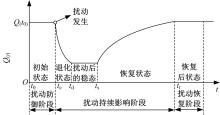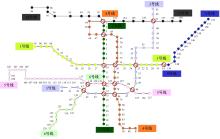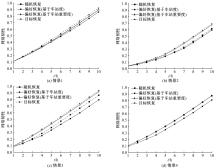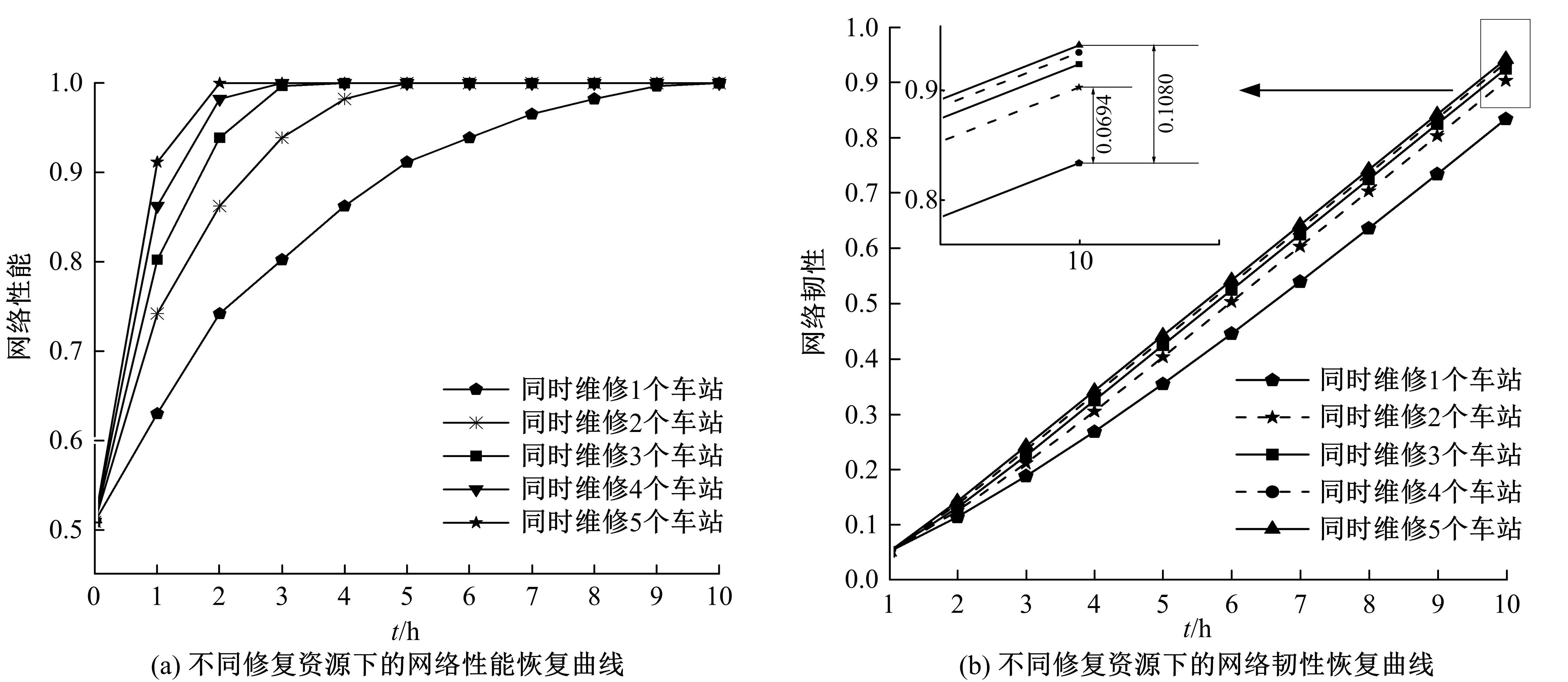Journal of Jilin University(Engineering and Technology Edition) ›› 2023, Vol. 53 ›› Issue (2): 396-404.doi: 10.13229/j.cnki.jdxbgxb20220453
Previous Articles Next Articles
Resilience assessment and recovery strategy on urban rail transit network
Min MA( ),Da-wei HU(
),Da-wei HU( ),Lan SHU,Zhuang-lin MA
),Lan SHU,Zhuang-lin MA
- College of Transportation Engineering,Chang'an University,Xi'an 710064,China
CLC Number:
- U491
| 1 | Derrible S, Kennedy C. Network analysis of world subway systems using updated graph theory[J] Transportation Research Record, 2009(2112): 17-25. |
| 2 | 冯国强,李菁.城市轨道交通减排治污效应评估[J].中国人口·资源与环境, 2019, 29(10): 143-151. |
| Feng Guo-qiang, Li Jing. Assessment of emission reduction effect of urban rail transit[J]. China Population, Resources and Environment, 2019, 29(10): 143-151. | |
| 3 | 侯秀芳, 梅建萍, 左超. 2021年中国内地城轨交通线路概况[J]. 都市快轨交通, 2022, 35(1): 12-16. |
| Hou Xiu-fang, Mei Jian-ping, Zuo Chao. An overview of urban rail transit lines in the Chinese mainland in 2021[J]. Urban Rapid Rail Transit, 2022, 35(1): 12-16. | |
| 4 | Holling C S. Resilience and stability of ecological systems[J]. Annual Review of Ecology and Systematics, 1973, 4: 1-23. |
| 5 | Berdica K. An introduction to road vulnerability: what has been done, is done and should be done[J]. Transport Policy, 2002, 9(2): 117-127. |
| 6 | 杨金顺,孙洪运,李林波,等.道路交通系统恢复力研究进展综述[J].交通信息与安全,2014,32(3): 87-93. |
| Yang Jin-shun, Sun Hong-yun, Li Lin-bo, et al. Review of road transportation system resilience research[J]. Journal of Transportation Information and Safety, 2014, 32(3): 87-93. | |
| 7 | Bruneau M, Chang S E, Eguchi R T, et al. A framework to quantitatively asses and enhance the seismic resilience of communities[J]. Earthquake Spectra, 2003, 19(4): 733-752. |
| 8 | Ayyub B M. Practical resilience metrics for planning, design, and decision making[J]. ASCE-ASME Journal of Risk Uncertain Engineering Systems, Part A: Civil Engineering, 2015, 1(3): 04015008. |
| 9 | Zhang D, Du F, Huang H, et al. Resilience assessment of urban rail transit networks: Shanghai metro as an example[J]. Safety Science, 2018, 106: 230-243. |
| 10 | 张洁斐, 任刚, 马景峰, 等. 基于韧性评估的轨道交通网络修复时序决策方法[J]. 交通运输系统工程与信息, 2020, 2(4): 14-20. |
| Zhang Jie-fei, Ren Gang, Ma Jing-feng, et al. Decision-making method of repair sequence for metro network based on resilience evaluation[J]. Journal of Transportation Systems Engineering and Information Technology, 2020, 2(4): 14-20. | |
| 11 | 黄莺, 刘梦茹, 魏晋果, 等. 基于韧性曲线的城市轨道交通网络恢复策略研究[J]. 灾害学, 2021, 36(1): 32-36. |
| Huang Ying, Liu Meng-ru, Wei Jin-guo, et al. Research on urban metro network recovery strategy based on resilience curve[J]. Journal of Catastrophology, 2021, 36(1): 32-36. | |
| 12 | 吕彪,管心怡,高自强. 轨道交通网络服务韧性评估与最优恢复策略[J]. 交通运输系统工程与信息, 2021, 21(5): 198-205, 221. |
| Lv Biao, Guan Xin-yi, Gao Zi-qiang. Evaluation and optimal recovery strategy of metro network service resilience[J]. Journal of Transportation Systems Engineering and Information Technology, 2021, 21(5): 198-205, 221. | |
| 13 | Nan C, Sansavini G. A quantitative method for assessing resilience of interdependent infrastructures[J]. Reliability Engineering&System Safety, 2017, 157: 35-53. |
| 14 | Ouyang M, Dueñas-Osorio L, Min X. A three-stage resilience analysis framework for urban infrastructure systems[J]. Structural Safety, 2012, 36/37: 23-31. |
| 15 | 张海涛, 靖继鹏. 制造企业综合信息竞争力测度模型的建立[J]. 吉林大学学报: 工学版, 2005, 35(3): 339-342. |
| Zhang Hai-tao, Jing Ji-peng. Measure model for manufacturing enterprise integrated information competitive power[J]. Journal of Jilin University(Engineering and Technology Edition), 2005, 35(3): 339-342. | |
| 16 | 朱天曈, 丁坚勇, 郑旭. 基于改进TOPSIS法和德尔菲——熵权综合权重法的电网规划方案综合决策方法[J]. 电力系统保护与控制, 2018, 46(12): 91-99. |
| Zhu Tian-tong, Ding Jian-yong, Zheng Xu. A comprehensive decision-making method for power network planning schemes based on the combination of the improved TOPSIS method with Delphi-entropy weight method[J]. Power System Protection and Control, 2018, 46(12): 91-99. | |
| 17 | 陈国芳, 卫豪. 基于EW-AHP和未确知测度理论的隧道瓦斯风险评价[J]. 有色金属科学与工程, 2021, 12(5): 89-95. |
| Chen Guo-fang, Wei Hao. Tunnel gas risk assessment based on EW-AHP and unascertained measurement theory[J]. Nonferrous Metals Science and Engineering, 2021, 12(5): 89-95. | |
| 18 | 魏丽英, 李鸣君. 考虑诱导影响的公交优先信号配时模型[J]. 吉林大学学报: 工学版, 2016, 46(3): 777-784. |
| Wei Li-ying, Li Ming-jun. Bus priority signal timing model considering the influence of traffic guidance[J]. Journal of Jilin University(Engineering and Technology Edition), 2016, 46(3): 777-784. | |
| 19 | 阳光灿,熊禾根.改进遗传算法求解柔性作业车间调度问题[J].计算机仿真,2022,39(2):221-225, 292. |
| Yang Guang-can, Xiong He-gen.Improved genetic algorithm for flexible job shop scheduling problem[J]. Computer Simulation, 2022, 39(2): 221-225, 292. | |
| 20 | 徐力,刘云华,王启富.自适应遗传算法在机器人路径规划的应用[J]. 计算机工程与应用, 2020, 56(18): 36-41. |
| Xu Li, Liu Yun-hua, Wang Qi-fu. Application of adaptive genetic algorithm in robot path planning[J]. Computer Engineering and Applications, 2020, 56(18): 36-41. | |
| 21 | 张超群, 郑建国, 钱洁. 遗传算法编码方案比较[J]. 计算机应用研究, 2011, 28(3): 819-822. |
| Zhang Chao-qun, Zheng Jian-guo, Qian Jie, Comparison of coding schemes for genetic algorithms[J]. Application Research of Computers, 2011, 28(3): 819-822. | |
| 22 | 周伟, 李敏, 丘铭军, 等. 基于改进遗传算法的车身板件厚度优化[J]. 清华大学学报: 自然科学版, 2022, 62(3): 523-532. |
| Zhou Wei, Li Min, Qiu Ming-jun, et al. Vehicle body panel thickness optimization by a genetical algorithm [J]. Journal of Tsinghua University(Science and Technology), 2022, 62(3): 523-532. |
| [1] | Jing WANG,Feng WAN,Chun-jiao DONG,Chun-fu SHAO. Modelling on catchment area and attraction intensity of urban rail transit stations [J]. Journal of Jilin University(Engineering and Technology Edition), 2023, 53(2): 439-447. |
| [2] | Song FANG,Jian-xiao MA,Gen LI,Ling-hong SHEN,Chu-bo XU. Traffic risk analysis of moving work zone on right lane of city expressway [J]. Journal of Jilin University(Engineering and Technology Edition), 2022, 52(8): 1786-1791. |
| [3] | Song-xue GAI,Xiao-qing ZENG,Xiao-yuan YUE,Zi-hao YUAN. Parking guidance model based on user and system bi⁃level optimization algorithm [J]. Journal of Jilin University(Engineering and Technology Edition), 2022, 52(6): 1344-1352. |
| [4] | Hong-feng XU,Hong-jin CHEN,Dong ZHANG,Qian-hui LU,Na AN,Xian-cai Geng. Fully⁃actuated signal timing technique for isolated signalized intersections in connected vehicle environment [J]. Journal of Jilin University(Engineering and Technology Edition), 2022, 52(6): 1324-1336. |
| [5] | Guo-zhu CHENG,Qiu-yue SUN,Yue-bo LIU,Ji-long CHEN. Cut⁃in behavior model based on game theoretic approach on urban roads [J]. Journal of Jilin University(Engineering and Technology Edition), 2022, 52(12): 2839-2844. |
| [6] | Heng-yan PAN,Wen-hui ZHANG,Bao-yu HU,Zun-yan LIU,Yong-gang WANG,Xiao ZHANG. Construction and robustness analysis of urban weighted subway⁃bus composite network [J]. Journal of Jilin University(Engineering and Technology Edition), 2022, 52(11): 2582-2591. |
| [7] | Zhuang-lin MA,Shan-shan CUI,Da-wei HU. Urban residents' low⁃carbon travel intention after implementation of driving restriction policy [J]. Journal of Jilin University(Engineering and Technology Edition), 2022, 52(11): 2607-2617. |
| [8] | Cui-yu LI,Ya-meng HU,Ya-wei KANG,De-liang ZHANG. Coordination scheduling of electric vehicle charge and discharge using adaptive genetic algorithm [J]. Journal of Jilin University(Engineering and Technology Edition), 2022, 52(11): 2508-2513. |
| [9] | Jing-xian WU,Hua-peng SHEN,Yin HAN,Min YANG. Residents' commuting time model under the nonlinear impact of urban built environment [J]. Journal of Jilin University(Engineering and Technology Edition), 2022, 52(11): 2568-2573. |
| [10] | Jie MA,Jia-jun HUANG,Jun TIAN,Yang-hui DONG. Simulation modeling of pedestrian target decision⁃making in evacuation process in transfer corridors of subway stations [J]. Journal of Jilin University(Engineering and Technology Edition), 2022, 52(11): 2600-2606. |
| [11] | Feng XUE,Chuan-lei HE,Qian HUANG,Jian LUO. Coordination degree of multimodal rail transit network [J]. Journal of Jilin University(Engineering and Technology Edition), 2021, 51(6): 2040-2050. |
| [12] | Bo PENG,Yuan-yuan ZHANG,Yu-ting WANG,Ju TANG,Ji-ming XIE. Automatic traffic state recognition from videos based on auto⁃encoder and classifiers [J]. Journal of Jilin University(Engineering and Technology Edition), 2021, 51(3): 886-892. |
| [13] | Dian-hai WANG,Xin-yi SHEN,Xiao-qin LUO,Sheng JIN. Offset optimization with minimum average vehicle delay [J]. Journal of Jilin University(Engineering and Technology Edition), 2021, 51(2): 511-523. |
| [14] | Xian-min SONG,Ming-ye ZHANG,Zhen-jian LI,Xin WANG,Ya-nan ZHANG. Setting of dynamic bus lane and its simulation analysis and evaluation [J]. Journal of Jilin University(Engineering and Technology Edition), 2020, 50(5): 1677-1686. |
| [15] | Hong-fei JIA,Xin-ru DING,Li-li YANG. Bi-level programming model for optimization design of tidal lane [J]. Journal of Jilin University(Engineering and Technology Edition), 2020, 50(2): 535-542. |
|







